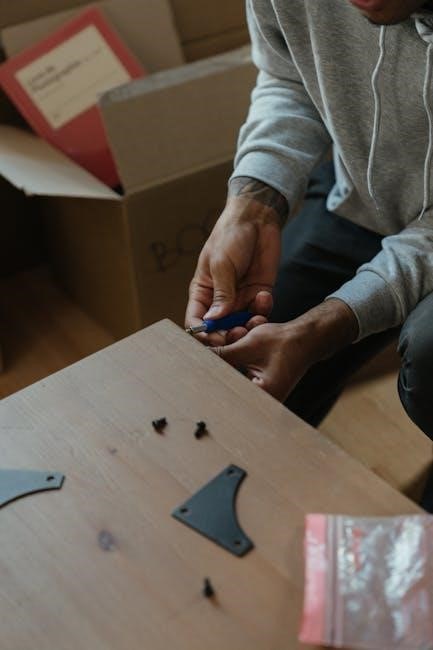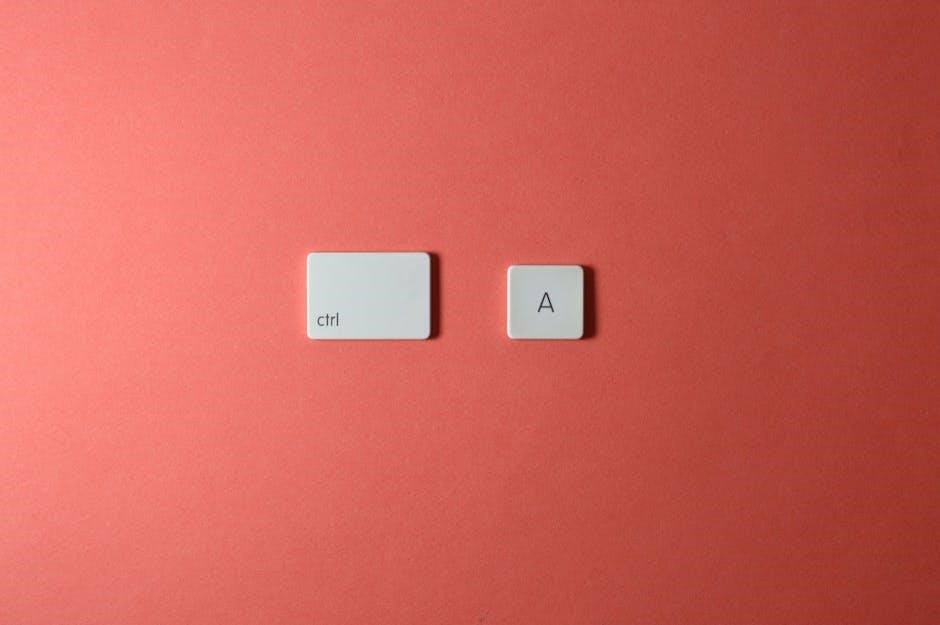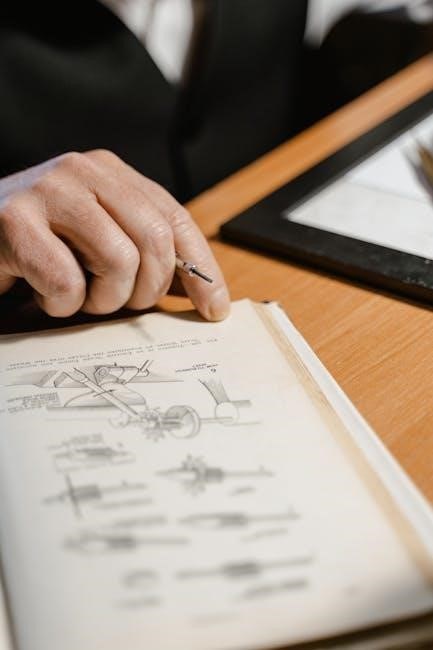Unboxing and Initial Setup
Unbox the JBL Charge 3 speaker, power adapter, and quick-start guide. Ensure all items are included and undamaged. Charge the speaker fully before first use for optimal performance.
What’s in the Box
The JBL Charge 3 box includes the portable Bluetooth speaker, a power adapter, a quick-start guide, and warranty information. The speaker features a built-in power bank, enabling charging of external devices. It also supports JBL Connect for pairing multiple speakers. The package ensures everything needed for setup is provided, with clear instructions for initial use. The speaker is IPX7 waterproof, making it durable for outdoor use. All components are designed for convenience and performance, ensuring a seamless experience right out of the box.
First-Time Setup
Before using the JBL Charge 3, ensure the speaker is fully charged. Connect the power adapter to the speaker and a power source. Once charged, press and hold the power button until the speaker turns on. The blue LED will indicate it’s powered up. For initial pairing, press the Bluetooth button to enter pairing mode. The speaker will emit a beep and the LED will flash. On your device, select “JBL Charge 3” from the Bluetooth settings to establish a connection. If issues arise, reset the speaker by pressing the volume up and play buttons simultaneously for 10 seconds. Follow these steps for a smooth first-time setup.
Charging the Battery
To charge the JBL Charge 3, use the provided USB-C cable and a compatible wall adapter. Connect the cable to the speaker’s USB-C port and the other end to the adapter. Plug the adapter into a power outlet. The LED indicator will turn red, signaling charging has begun. Full charge typically takes about 4.5 hours. Avoid interrupting the charging process. Once fully charged, the LED will turn off or change color, depending on the model. Ensure the speaker is charged before extended use. For optimal battery health, avoid overcharging and keep the speaker away from extreme temperatures during charging. Always use the original charger for best results.

Design and Build Quality
The JBL Charge 3 features a rugged, cylindrical design with a durable fabric cover and rubberized ends for shock resistance. It weighs 800 grams, making it lightweight yet sturdy. The IPX7 waterproof rating ensures protection against water immersion. Available in multiple colors, the speaker combines portability with a premium feel. The build quality is robust, designed for outdoor use, with a comfortable handle for easy carrying.
Physical Design Overview
The JBL Charge 3 boasts a sleek, cylindrical design with a durable fabric cover and rubberized ends for enhanced durability. Weighing 800 grams, it is lightweight yet robust, perfect for portability. The speaker measures 213 x 87 x 88.5 mm, offering a compact yet powerful presence. Its rounded edges and sturdy handle make it easy to carry. Available in multiple colors, the Charge 3 combines style with functionality. The design emphasizes simplicity, with a focus on user-friendly controls and a premium feel. Its rugged construction ensures reliability, making it suitable for both indoor and outdoor use. The overall build reflects JBL’s commitment to blending aesthetics with practicality.
Water Resistance Rating
The JBL Charge 3 features an IPX7 water resistance rating, providing protection against immersion in water up to 1.5 meters for 30 minutes. This ensures durability in wet environments. To maintain its water resistance, ensure all ports are tightly closed and free from debris. Avoid exposing the speaker to high water pressure or extreme conditions. After exposure to water, gently wipe the surface to prevent damage. Regular maintenance, such as cleaning the ports, is essential to preserve its waterproofing. This rating makes the Charge 3 ideal for poolside use, beach trips, or rainy conditions, offering reliable performance in various settings.
Control Buttons Layout
The JBL Charge 3 features a user-friendly control panel located on the top of the speaker. From left to right, you’ll find the power button, volume up, play/pause, volume down, and the JBL Connect button. The power button lights up when the speaker is on, while the play/pause button also handles call management. The volume controls allow for precise sound adjustment, and the JBL Connect button enables pairing with other JBL speakers for a surround sound experience. The buttons are ergonomically designed for easy access and intuitive use, making it simple to manage your music playback and speaker settings effortlessly.

Connecting to Devices
Easily connect the JBL Charge 3 to your device via Bluetooth or the 3.5mm auxiliary input. Pair multiple devices simultaneously for seamless music switching and enhanced versatility.
Bluetooth Pairing Process
To pair the JBL Charge 3 via Bluetooth, ensure the speaker is turned on and in pairing mode. The speaker will emit a blue light when ready. Open your device’s Bluetooth settings and select “JBL Charge 3” from the available options. Once connected, you’ll hear a confirmation tone. If pairing fails, reset the speaker by pressing and holding the Bluetooth button for 3 seconds. The process is straightforward and quick, allowing you to start streaming music within minutes. Make sure your device is within range for a stable connection.
Connecting Multiple Devices
The JBL Charge 3 allows seamless connection of up to two devices simultaneously. To connect a second device, ensure Bluetooth is enabled on both devices. Once the first device is paired, the speaker will automatically detect and connect to the second device when it is in range. You can switch between devices by pausing playback on one and resuming on the other. The speaker remembers up to eight previously connected devices for quick reconnection. For optimal performance, ensure devices are within 30 feet of the speaker and avoid obstacles that may interfere with the Bluetooth signal.
Using the 3.5mm Auxiliary Input
The JBL Charge 3 features a 3.5mm auxiliary input, allowing wired connections to devices without Bluetooth capability. To use this feature, locate the aux input port on the speaker’s rear panel. Connect one end of a 3.5mm audio cable to the speaker and the other to your device’s headphone jack. Ensure the cable is fully inserted for a secure connection. Once connected, the speaker will automatically switch to auxiliary mode, bypassing Bluetooth. You can now play audio directly from your device. This option is ideal for older devices or when Bluetooth pairing is not available. Always use a high-quality cable to maintain sound clarity and avoid connection issues.

JBL Connect and Wireless Features
JBL Connect enables seamless wireless syncing between multiple JBL speakers, creating an immersive sound experience. Use the JBL Connect button to pair speakers effortlessly for synchronized playback.
What is JBL Connect?
JBL Connect is a wireless technology that allows multiple JBL speakers to be paired together for a synchronized audio experience. This feature enhances sound by creating a stereo or party mode, perfect for outdoor gatherings or large spaces. By pressing the JBL Connect button on each speaker, users can easily link devices, ensuring seamless music playback across all connected speakers. The technology supports up to 100 JBL Connect-compatible speakers, offering a powerful and immersive sound environment. This feature is particularly popular for its ease of use and ability to elevate any setting with high-quality, synchronized audio.
Pairing Multiple JBL Speakers
To pair multiple JBL speakers, use the JBL Connect feature. Press the JBL Connect button on each speaker to initiate pairing. The LED indicators will flash, confirming the connection. Once paired, speakers can operate in stereo or party mode, enhancing sound quality and coverage. This feature supports up to 100 JBL Connect-enabled speakers, creating an immersive audio experience. Ensure all speakers are JBL Connect-compatible and follow the pairing sequence for seamless synchronization. This setup is ideal for outdoor events or large spaces, providing powerful and synchronized sound across all connected devices.
Using the JBL Connect App
The JBL Connect app allows users to customize and control their JBL Charge 3 speaker. Download the app from the App Store or Google Play Store. Once installed, connect your speaker to the app via Bluetooth. The app enables firmware updates, ensuring your speaker has the latest features. Customize settings like EQ presets to tailor sound to your preference. Use the app to pair multiple JBL speakers for a synchronized audio experience. Additionally, the app provides troubleshooting guides and user manuals for easy reference. It’s a comprehensive tool to enhance your JBL Charge 3 experience, offering advanced control and personalized settings;

Battery Management
Monitor the JBL Charge 3’s battery life using the LED indicators. Green indicates a full charge, while red signals low battery. Charge via the USB-C port for up to 20 hours of playtime.
Checking Battery Life
To check the battery life of your JBL Charge 3, refer to the LED indicators located on the top of the speaker. These lights provide visual feedback about the current battery level:
- Green Light: Indicates a full charge or a high battery level.
- Red Light: Signals a low battery level, meaning the speaker needs to be charged soon.
- Flashing Red Light: Indicates that the battery level is critically low, and the speaker will soon power off.
In addition to the LED indicators, you can also monitor the battery level using the JBL Connect+ app. The app provides a more precise percentage-based reading of the remaining battery life. For optimal performance, ensure the speaker is fully charged before extended use.
Charging the Speaker
To charge the JBL Charge 3, use the provided USB-C cable and a compatible power adapter. Connect the cable to the speaker’s USB-C port and plug the other end into the adapter. The LED indicator will turn red to confirm charging. Avoid using third-party chargers to prevent damage. The speaker takes approximately 4-5 hours to fully charge. During charging, the LED will remain red. Once fully charged, the LED will turn off or change to green, depending on the model. Ensure the speaker is completely charged before first use for optimal performance. Always monitor the LED indicators to track the charging progress.
Understanding LED Indicators
The JBL Charge 3 uses LED indicators to show its status. A red LED indicates the speaker is charging, while a green LED signals a full charge. When pairing via Bluetooth, the LED flashes blue rapidly. A steady blue light confirms successful pairing. If the battery is low, the LED flashes red three times. During JBL Connect mode, the LED flashes white. These indicators help you monitor the speaker’s power, connection, and pairing status. Always check the LEDs to ensure proper functionality and avoid issues. The LED system provides clear visual feedback for seamless user experience.

Sound Quality and Settings
The JBL Charge 3 delivers balanced sound with deep bass and clear highs. Adjust equalization settings and volume limits for optimal audio experience.
Equalization Options
The JBL Charge 3 offers customizable EQ settings to enhance your listening experience. Use the JBL Connect app to adjust bass, treble, and mid-range frequencies. Preset modes like ‘Bass Boost’ and ‘Vocal Clarity’ cater to different music genres. Manual tuning allows precise audio customization. These settings ensure optimal sound reproduction, whether you’re listening to deep bass tracks or detailed vocal performances. Experiment with different configurations to find your perfect sound profile. Remember to save your preferences for consistent playback across all connected devices.
Volume Control and Limits
To set volume limits on the JBL Charge 3, use the JBL Connect app. Download and install the app, then connect your device via Bluetooth. In the app, navigate to the sound settings section. Locate the “Volume Limit” option and adjust the slider to your desired maximum volume. Test the sound to ensure it’s within a safe range and doesn’t cause distortion. The LED indicator will flash red if the volume is too high, signaling potential damage. To prevent accidental changes, enable the “Volume Lock” feature, which requires a password. Restart the speaker after saving these settings to ensure they take effect. This setup helps protect the speakers and maintains optimal sound quality.
Bass Response and Sound Profile
The JBL Charge 3 delivers deep bass and clear highs, making it ideal for genres requiring strong low-frequency response. Use the JBL Connect app to customize the sound profile. Adjust the equalizer settings to enhance bass or treble. For optimal listening, place the speaker on a flat surface to allow the bass ports to function properly. Avoid muffling the speaker with objects or placing it upside down. The dual 50mm drivers and built-in passive radiators ensure balanced sound reproduction. Experiment with settings for different music types to find your preferred sound signature. This ensures the speaker performs at its best across various audio formats and environments.

Troubleshooting Common Issues
Resolve common issues like no sound or distorted audio by resetting the speaker or checking Bluetooth connectivity. Address water damage by drying the speaker thoroughly before use.
No Sound or Distorted Audio
If the JBL Charge 3 produces no sound or distorted audio, check the volume levels on both the speaker and connected device. Ensure Bluetooth is properly paired and no devices are muted. Restart the speaker and device, then reconnect. If issues persist, reset the speaker by pressing and holding the volume up and play buttons for 10 seconds. Distorted audio may also result from low battery; charge the speaker fully. Avoid exposure to extreme temperatures or moisture, which can affect sound quality. Regularly update firmware to resolve software-related issues.
Bluetooth Connectivity Problems
If experiencing Bluetooth connectivity issues with the JBL Charge 3, restart the speaker and ensure it is in pairing mode. Check the device’s Bluetooth settings and confirm it is searching for available devices. Move the speaker and device closer to eliminate interference. If paired previously, remove the speaker from the device’s Bluetooth list and pair again. Restart both devices and ensure the speaker is fully charged. If issues persist, reset the speaker by pressing and holding the volume up and play buttons for 10 seconds. This restores default settings and resolves connectivity problems effectively.
Water Damage Recovery Steps
If the JBL Charge 3 is exposed to water, act quickly to minimize damage. Turn off the speaker immediately and disconnect any cables. Gently remove the grille and drain excess water. Use a soft cloth to pat dry the exterior and ports. Avoid using heat sources like hair dryers, as they can cause internal damage. Let the speaker air dry in a cool, well-ventilated area for 24-48 hours. Once dry, test functionality. If issues persist, contact JBL customer support for repair or replacement options. Note that water damage may void the warranty if precautions were not followed.

Updating Firmware and Maintenance
Regular updates ensure optimal performance. Use the JBL Connect app to check for firmware updates. Follow on-screen instructions to download and install the latest version. Always update over a stable Wi-Fi connection. After installation, restart the speaker to apply changes. Maintain the speaker by cleaning dust from grilles and ports with a soft brush. Avoid harsh chemicals or liquids. Proper maintenance extends the speaker’s lifespan and ensures peak audio quality. For detailed instructions, refer to the official JBL support website or user manual.
How to Update Firmware
To update the JBL Charge 3 firmware, download and install the latest version using the JBL Connect app. Ensure the speaker is fully charged and connected via Bluetooth to your device. Open the app, navigate to the settings menu, and select “Firmware Update.” Follow the on-screen instructions to download and install the update. The speaker will automatically restart during the process. Do not unplug or turn off the speaker until the update is complete. The LED indicator will flash to confirm the update is successful. Regular firmware updates improve performance, fix issues, and add new features to your speaker.
Resetting the Speaker
Resetting the JBL Charge 3 restores it to factory settings, resolving connectivity or sound issues. To reset, press and hold the “Volume Up” and “Bluetooth” buttons for 10 seconds. The speaker will turn off, indicating the reset process has started. Release the buttons and wait for the speaker to restart. Once powered on, pair the speaker with your device again. Note that resetting will erase all previously paired devices. Ensure the speaker is fully charged before performing the reset for optimal results. This process is helpful if the speaker is malfunctioning or if you’re transferring ownership.
Cleaning and Maintaining the Speaker
To maintain the JBL Charge 3’s performance and longevity, clean it regularly. Turn off the speaker and unplug it before cleaning. Use a soft, dry cloth to wipe down the exterior, paying attention to the control buttons and grille. For tougher stains, dampen the cloth slightly, but avoid soaking the speaker. Avoid harsh chemicals or abrasive materials that could damage the finish or waterproof coating. Clean the grille gently with a soft-bristled brush to remove dust. Allow the speaker to dry completely before turning it on. Regularly inspect and clean the charging port to ensure proper connectivity. Store the speaker in a protective case when not in use to prevent damage.

Accessories and Compatibility
The JBL Charge 3 is compatible with various devices via Bluetooth or the 3.5mm aux input. Recommended accessories include a protective case and a micro-USB cable.
Compatible Devices List
The JBL Charge 3 is compatible with a wide range of devices, including smartphones, tablets, laptops, and MP3 players. It supports Bluetooth-enabled devices and can connect via the 3.5mm auxiliary input. The speaker is designed to work seamlessly with Android and iOS devices. For non-Bluetooth devices, the aux input ensures connectivity. The JBL Charge 3’s compatibility extends to voice assistants like Siri and Google Assistant, enhancing its functionality. Ensure your device is Bluetooth-enabled or has a 3.5mm output for optimal performance. This versatility makes the JBL Charge 3 a versatile option for various audio setups and preferences.
Recommended Accessories
Enhance your JBL Charge 3 experience with recommended accessories. A high-quality 3.5mm audio cable ensures reliable wired connections. A water-resistant carry pouch protects the speaker during outdoor adventures. For extended playtime, consider a portable power bank to recharge the speaker on the go. A Bluetooth transmitter can connect non-Bluetooth devices seamlessly. Additionally, a microfiber cloth helps maintain the speaker’s exterior. These accessories complement the JBL Charge 3’s features, ensuring optimal performance and longevity. They are designed to enhance portability, connectivity, and overall user satisfaction, making the speaker even more versatile for various settings and preferences.
Storage and Travel Tips
Store the JBL Charge 3 in a protective case to prevent scratches and damage. Ensure the speaker is dry before storage to avoid moisture buildup. When traveling, pack the speaker securely in a bag or luggage to minimize movement. Use the provided carry strap for easy transport. Avoid extreme temperatures and exposure to direct sunlight for prolonged periods. Disconnect all cables and close the charging port tightly to maintain water resistance. For extended storage, charge the battery to 50% to preserve its lifespan. These tips ensure your JBL Charge 3 remains in great condition, ready for your next adventure or gathering.

Warranty and Support
The JBL Charge 3 comes with a one-year warranty covering manufacturing defects. Contact customer support via phone or email for assistance. Register your product for warranty validation.
Warranty Information
The JBL Charge 3 is backed by a one-year limited warranty covering manufacturing defects. For warranty service, contact JBL support via phone, email, or their official website. Ensure your product is registered on JBL’s website to validate the warranty. The warranty does not cover damage caused by misuse, accidents, or unauthorized repairs. Check local laws for additional rights, as warranty terms may vary by region. Keep your purchase receipt as proof of ownership when filing a claim.
Contacting Customer Support
For assistance with your JBL Charge 3, visit the official JBL website and navigate to the support section. Use the “Contact Us” form to submit inquiries or call the local customer service number. Support is available in multiple languages. Additionally, JBL offers live chat and email support for troubleshooting. When contacting, have your product serial number ready for faster service. Check the website for regional support hours. JBL’s dedicated team aims to resolve issues promptly, ensuring a smooth user experience. Always refer to official channels for authentic support to avoid unauthorized assistance. Keep your product details handy for efficient communication.
Registering Your Product
Register your JBL Charge 3 on the official JBL website to activate warranty benefits and gain access to exclusive support services. Visit the JBL support page, click on “Product Registration,” and fill in the required details, including your name, email, and product serial number. Ensure all information is accurate to avoid delays. Once submitted, you will receive a confirmation email. Keep this confirmation for future reference. Registering your product helps JBL provide tailored support and improves their services. For assistance with registration, contact JBL customer support directly. Accurate registration ensures seamless warranty claims and enhanced customer experience. Register your JBL Charge 3 today to maximize its benefits.
The JBL Charge 3 offers exceptional sound quality, durability, and portability, making it an excellent choice for music enthusiasts. Its long battery life and waterproof design ensure versatility for any setting, while the intuitive controls and robust build make it a reliable companion for indoor or outdoor use. With its powerful audio performance and sleek design, the JBL Charge 3 is a standout portable speaker that delivers on its promises, providing an immersive listening experience wherever you go.
Key Takeaways
- The JBL Charge 3 is a high-powered, portable Bluetooth speaker designed for immersive audio experiences.
- It features a robust build, IPX7 water resistance, and up to 20 hours of playtime on a single charge.
- The speaker supports JBL Connect, enabling wireless pairing with other JBL speakers for amplified sound.
- With a built-in power bank, it can charge external devices, adding convenience for on-the-go use.
- Regular firmware updates and proper maintenance ensure optimal performance and longevity.
- Its intuitive controls and versatile design make it ideal for both indoor and outdoor settings.
Overall, the JBL Charge 3 is a reliable and feature-rich speaker that delivers exceptional sound quality and durability.
Final Recommendations
For the best experience with the JBL Charge 3:
- Use high-quality audio sources to maximize sound performance.
- Explore the equalization settings to tailor the sound to your preferences.
- Pair multiple JBL speakers using JBL Connect for an immersive audio setup.
- Keep the firmware updated to ensure all features function optimally.
- Regularly clean the speaker to maintain its appearance and performance.
- Consider purchasing JBL-recommended accessories for enhanced functionality.
By following these tips, you can enjoy the full potential of your JBL Charge 3 and extend its longevity.
Additional Resources
For further assistance with your JBL Charge 3:
- Visit the official JBL website for the latest manuals and guides.
- Download the JBL Charge 3 PDF manual for detailed instructions.
- Check out JBL Connect app resources for wireless features.
These resources provide comprehensive support to enhance your user experience.
